AMD Radeon HD 7750 & Radeon HD 7770 GHz Edition Review: Evading The Price/Performance Curve
by Ryan Smith & Ganesh T S on February 15, 2012 12:01 AM EST- Posted in
- GPUs
- AMD
- HTPC
- GCN
- Radeon HD 7000
Power, Temperature, & Noise
As always, we wrap up our look at a new video card with a look at the physical performance attributes: power consumption, temperatures, and noise.
While it’s the second sub-series of the 7000 series, the 7700 series is actually first in a number of ways for AMD. It’s the first midrange series to feature PowerTune since its introduction in 2010, and it’s the first time the 28nm process has been used on such low power cards. As such the power, temperature, and noise characteristics of the 7700 series are virtually a blank slate waiting to be filled.
| Radeon HD 7700 Series Voltages | ||||
| Ref 7750 Load | Ref 7770 Load | XFX R7770 BESDD | ||
| 1.1v | 1.2v | 1.2v | ||
The idle voltage for all 3 of our 7700 series cards was 0.825v. Meanwhile the load voltage for our 7750 was 1.1v, while it was 1.2v for both the reference 7770 and the XFX BESDD.
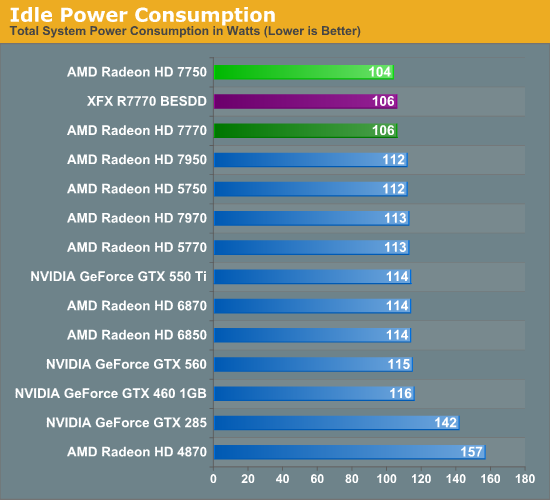
AMD’s official idle power consumption figure is <10W for both the 7750 and 7750. In practice we find that there’s a 2W difference between the two cards, with the 7750 coming in at 104W at the wall and the 7770 at 106W. AMD’s continuing efforts to reduce idle power consumption are clearly paying off, making this the lowest idle power usage figures we’ve recorded yet.
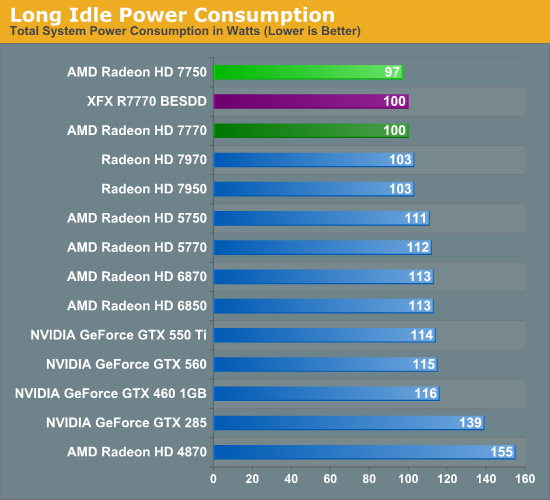
Meanwhile under the so-called “long idle” scenario with a blank monitor, the 7000 series continues to cement its lead. Officially all Southern Islands cards have a long idle power consumption level of <3W since they should all be using the same PCIe controller to keep a heartbeat going, however we’re finding there is a difference, even between the 7750 and 7770. The 7770 consumes 3W less than the 7900 series, meanwhile the 7750W consumes another 3W less, bringing it down to 97W. Since our readings are from the wall it’s tough to gage just how much these cards are still using, but at this point there doesn’t seem to be much farther to drop.
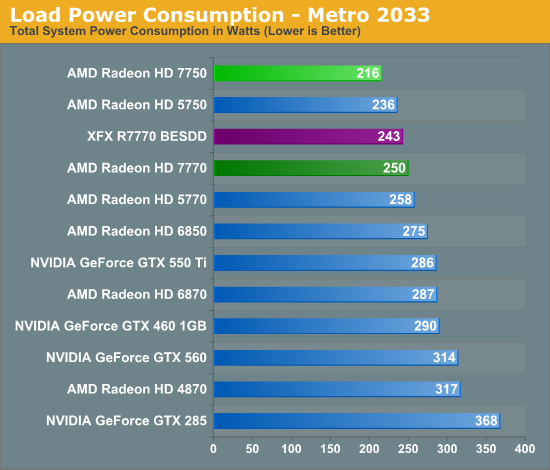
When we talk about the 7700 series bluring the line between what we’d expect out of an AMD 700 series card and an AMD 600 series card, results like this are part of the reason why. With a 75W PowerTune limit the 7750 has the lowest power consumption of any of the cards in our lineup, beating even the 5750. The 7750 is clearly in a league of its own, with only the 7770 drawing similar amounts of power as the 5700 series.
To that extent, it’s interesting to note that the XFX BESDD consumes less power than the reference 7770, in spite of its factory overclock. XFX did not increase the voltage of the card, but we’d still expect power consumption to go up at least a bit, not come down. In any case even with its 10% better performance, it’s consuming 7W less than the reference 7770 here. Otherwise at 250W the 7770 is pulling 8W less than the 5770 and 25W less than the 6850 from the wall, succinctly showcasing the power benefits of TSMC’s 28nm process.
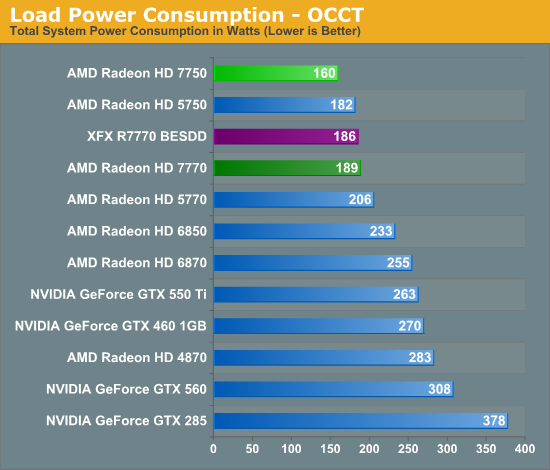
Our results with OCCT largely mirror Metro, with the 7750 in a class of its own while the 7770 consumes less power than anything other than the 5750. Since this is our pathological test, the lack of PowerTune plays a big part here, as PowerTune keeps the 7770 capped at 100W while the 5770 and 6850 are free to go well over their TDPs.
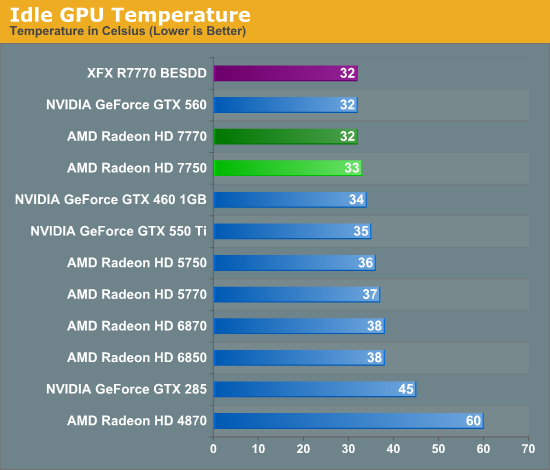
There’s little to say about idle temperatures that hasn’t been said before. With a half-decent cooler, almost any card can reach the mid-to-low 30s. The 7700 series is no exception.
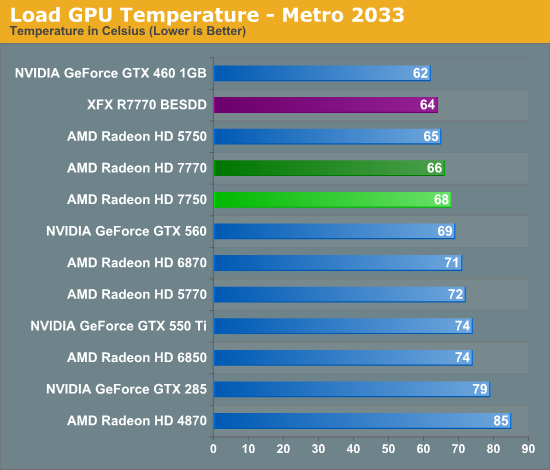
Moving on to Metro, our results are largely consistent with what we’d expect given our earlier power data. Even with the lower power consumption of the 7700 series AMD can’t quite beat the GTX 460 1GB, otherwise with temperatures in the mid to upper 60s the 7700 series looks quite good. XFX’s BESDD looks especially good thanks to the fact that it’s an open air cooler, as it only reaches 64C.

As with OCCT power consumption, OCCT temperatures are largely a story of PowerTune or the lack thereof. With PowerTune clamping down on power consumption, temperatures never rise by too much. At 71C the reference 7770 is still doing well, while XFX’s card does even better.
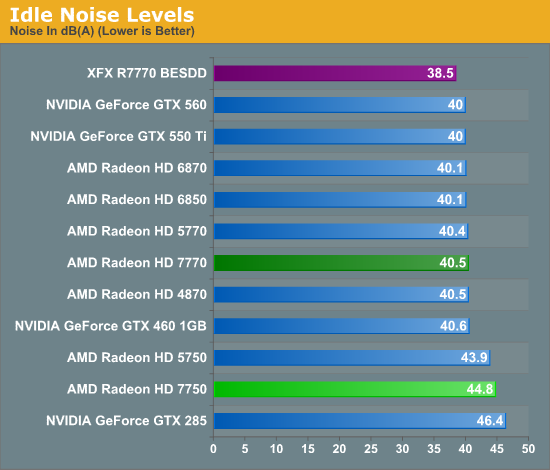
Based on our power and temperature data, our noise data came at somewhat of a disappointment. The 7750 has a small fan with an idle fanspeed of 39%, leading to it being quite loud relative to its competitors. Thankfully none of AMD’s partners will be using that specific cooler, so we wouldn’t expect any retail cards to be this bad. Though if silence is key, Sapphire’s passively cooled 7750 is always an option.
As for our 7770 cards there aren’t any surprises. The open air cooled XFX BESDD does the best, though at only 40.5dB the reference 7770 is doing almost as well on its own.
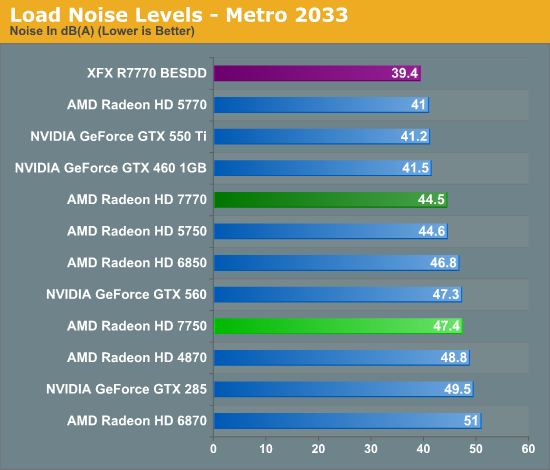
I had to rerun Metro a few times just to make sure our XFX BESDD numbers are right; and they were. XFX’s open air cooler combined with the 100W board limit of the 7770 means that there’s relatively little heat to dissipate, which the open air cooler does extremely well. While this isn’t technically silent it’s damn close.
Elsewhere the reference 7770 does decently, but its half blower nature hurts it when it comes to noise. The noisy 7750 only gets louder, unfortunately.
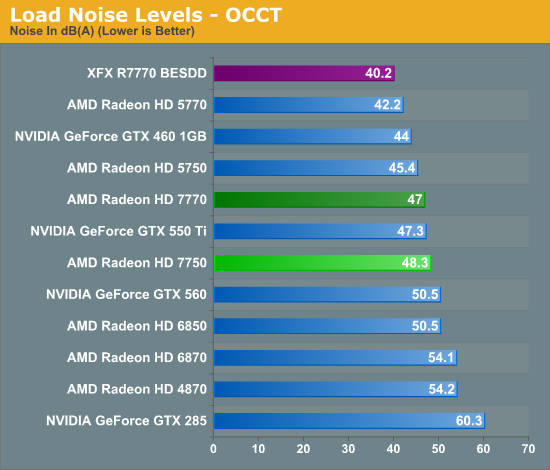
Finally, noise under OCCT is nearly the same story. The XFX BESDD finally goes above 40dB, a testament to the capabilities of XFX’s open air cooler. As for the AMD cards, there’s really not a great deal positive to say as even a traditional blower shouldn’t be quite as bad as what we’re seeing with the reference 7770. Perhaps it’s for the best that none of AMD’s partners are using their reference designs.










155 Comments
View All Comments
rdh - Wednesday, February 15, 2012 - link
Bingo. But your numbers look at if you were to want to buy today. You might have bought the 5750 or 5770 at a significantly lower cost during a sale in the past 2.5 years. So individual price comparisons may be different than today's prices.IN ADDITION: the 7770 and 7750 require about 3% less power and produce frame rates about 10% higher than their 57xx counterparts. This is after the 57xx have been out for nearly TWO AND HALF YEARS. I purchased both (the 5750 for one system at $65 and the 5770 for another at $99) about 6 months after introduction. Two years later, there is no compelling reason for me to upgrade. That means AMD is only going to be selling these to new desktop purchasers.... a quickly shrinking market. This cannot be good for AMD.
CeriseCogburn - Saturday, March 10, 2012 - link
Since fps is your only metric, itself being a murky and disturbed error filled easily biased mess based upon game set, driver cheating, resolutions, and in game settings chosen, the entire price/perf chart is EPIC FAIL.When your drivers crash, when your game doesn't work, when new games don't work for weeks and months, when dual card drivers are absent, when features like PhysX are no can do - NONE OF IT IS ACCOUNTED FOR....
---
Obviously all amd has to do is follow the simpleton idiot fps/per dollar formula for all the stuck cursor gsod fanboys to bloviate and screech they saved 20 cents... then the amd forum masters casn continue to lock them out, lock user problem threads, and smart off that "it's works for them on their eyefinity setup theya re starig at right now"...
---
When a crazed, worship filled, religious zealoutry claims the heavens have opened on the cheap and the devil competition has lost all, beware...
Oh.. wait... sorry talking to the wrong person...
Roland00Address - Wednesday, February 15, 2012 - link
I am curious how high these cards will go before they hit the powertune limits.Ryan Smith - Wednesday, February 15, 2012 - link
I'm still writing up an addendum, but here's what I have for the 7770.Ref 7770: 1125MHz core, 4.8GHz memory
XFX 7770: No meaningful overclock on top of XFX's factory overclock. Crashed at 1160MHz core
As for performance, basically look at the XFX card.
Roland00Address - Wednesday, February 15, 2012 - link
Personally I find that the more interesting cardRyan Smith - Wednesday, February 15, 2012 - link
We didn't do any overclocking tests on the 7750. It was necessary to quickly test it in order to be able to ship it to Ganesh for HTPC testing.DarkSynergyt - Wednesday, February 15, 2012 - link
Might be a stupid question but can the 7750 output audio over HDMI? I'm in the process of building an HTPC and this is the final piece to the build.evilspoons - Wednesday, February 15, 2012 - link
My 6570 can and I'm pretty sure they said in the review that it has all the same features as previous generations for video features.ganeshts - Wednesday, February 15, 2012 - link
Yes, it does. With full bitstreaming options too (even WMA Pro). 7.1 channel LPCM support is also there. No worries. (Of course, hot plugging [ say, moving from a direct monitor connection to an AV receiver input ] causes the audio output to act crazy, but that is the case with every card. Reboot fixes the issue)evilspoons - Wednesday, February 15, 2012 - link
This really drives home how obsolete my GTX 285 is. The 7770 has about equivalent performance and uses *130 watts* less.I need a new video card, but I want to see what Nvidia has for us next - I'm not a fanboy (in spite of all my gaming cards since the 3dfx Voodoo 3 being Nvidia), I'm just genuinely hoping for either some competition to drive prices down or something better to blow us away. Come on guys, get a move on already!